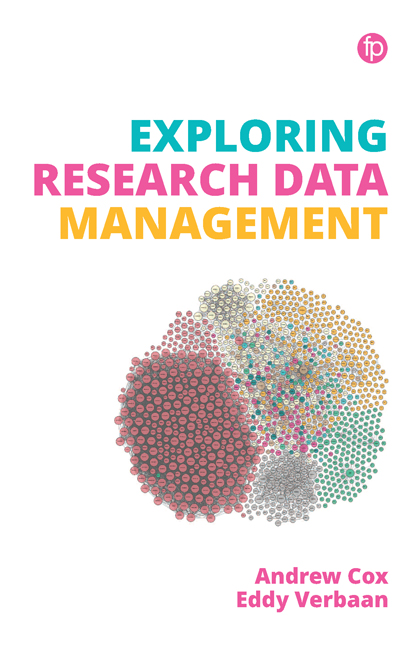Book contents
- Frontmatter
- Contents
- List of tables and figures
- 1 Introducing Research Data Management
- 2 The Social Worlds of Research
- 3 What Are Research Data?
- 4 Case Study of RDM in an Environmental Engineering Science Project
- 5 RDM: Drivers and Barriers
- 6 RDM as a Wicked Challenge
- 7 Research Data Services
- 8 Staffing a Research Data Service
- 9 Requirements Gathering for a Research Data Service
- 10 Institutional Policy and the Business Case for Research Data Services
- 11 Support and Advice for RDM
- 12 Practical Data Management
- 13 Data Management Planning
- 14 Advocacy for Data Management and Sharing
- 15 Training Researchers and Data Literacy
- 16 Infrastructure for Research Data Storage and Preservation
- 17 Evaluation of RDS
- 18 Ethics and Research Data Services
- 19 A Day in the Life Working in an RDS
- 20 Conclusion: the Skills and Mindset to Succeed in RDM
- Index
13 - Data Management Planning
Published online by Cambridge University Press: 21 September 2019
- Frontmatter
- Contents
- List of tables and figures
- 1 Introducing Research Data Management
- 2 The Social Worlds of Research
- 3 What Are Research Data?
- 4 Case Study of RDM in an Environmental Engineering Science Project
- 5 RDM: Drivers and Barriers
- 6 RDM as a Wicked Challenge
- 7 Research Data Services
- 8 Staffing a Research Data Service
- 9 Requirements Gathering for a Research Data Service
- 10 Institutional Policy and the Business Case for Research Data Services
- 11 Support and Advice for RDM
- 12 Practical Data Management
- 13 Data Management Planning
- 14 Advocacy for Data Management and Sharing
- 15 Training Researchers and Data Literacy
- 16 Infrastructure for Research Data Storage and Preservation
- 17 Evaluation of RDS
- 18 Ethics and Research Data Services
- 19 A Day in the Life Working in an RDS
- 20 Conclusion: the Skills and Mindset to Succeed in RDM
- Index
Summary
Aims
The aim of the chapter is to explain data management planning and to explore how best to support it.
The data management plan
Increasingly funders are requiring that any proposal for a project must include a detailed explanation of how research data will be managed during the project, including such aspects as how much data will be collected, in which formats, how participant confidentiality will be protected and which parts of the data will be shared at project close. This is often called a data management plan (DMP), though different funders give it different names.
The requirement to write a DMP may be one of the first times a researcher may encounter the idea of RDM. For many researchers this requirement may feel like an unwelcome extra hurdle in the long and arduous task of writing a research proposal. It is unclear if a bad DMP will really affect the likelihood of being funded. Because it deals with seemingly minute aspects of data management it may not feel very important, in the context of the wider ambitions of a project – although, as we saw in Chapter 4, data management could also be recognised as a cornerstone of a successful project. A researcher may well feel it is almost impossible to anticipate exactly how much data they might have in megabytes or what preservation formats they might choose. They are likely to see it as quite a technical document that needs input from the computing service, around what data storage facilities exist. But they are quite likely also to be unclear about what the funder is really looking for in writing such a document.
Because of the detail and unfamiliarity of the DMP, having to write one frequently leads researchers, right at the last minute before a proposal submission deadline, to seek help from the RDS. It will probably be one of the main enquiries from staff that the RDS receives. Working out how best to support researchers to write their DMP is a key task for the RDS. It is also a critical opportunity for the RDS, because it is one of the main occasions that researchers might actively seek help.
- Type
- Chapter
- Information
- Exploring Research Data Management , pp. 115 - 124Publisher: FacetPrint publication year: 2018
- 1
- Cited by

